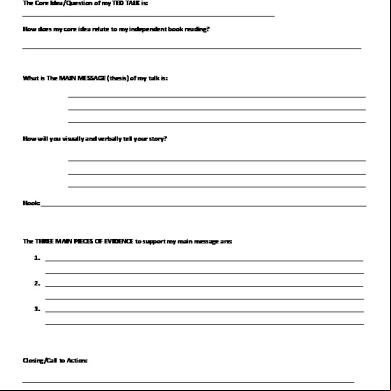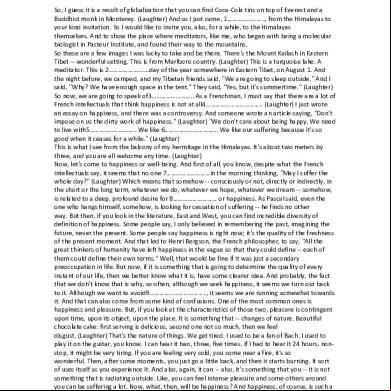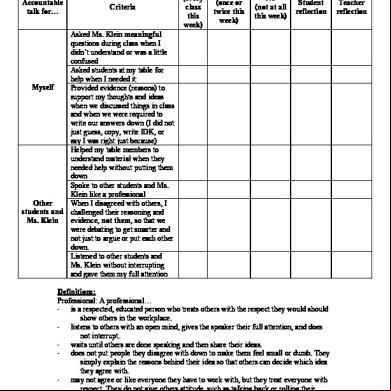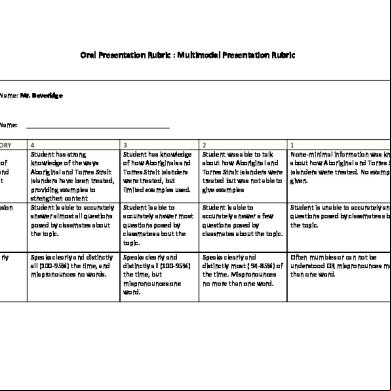Ted Talk Presentation Rubric 4u5r21
This document was ed by and they confirmed that they have the permission to share it. If you are author or own the copyright of this book, please report to us by using this report form. Report 2z6p3t
Overview 5o1f4z
& View Ted Talk Presentation Rubric as PDF for free.
More details 6z3438
- Words: 853
- Pages: 2
TED TALK PRESENTATION: ASSESSMENT AND EVALUATION Learning Goals:
To become more comfortable public speaking Identify and explain how rhetorical devices influence a speaker’s message Identify and explain how presentation technique influences a speaker’s message Apply effective presentation strategies to your own presentation
Specific Expectations for Assessment
1.1 Listening to Understand – listening to and watching Ted talks and identifying the main ideas 1.2 Active Listening Strategies- acknowledge others’ ideas when sharing information about talks viewed, and ask clarifying questions about their favourite selection if required using appropriate body language and facial expression 1.3 Listening Comprehension – oral summarizing of 5 talks watched for small group 1.4 Understanding of Content (explanation of core concepts to peers) 1.6 Extending Understanding (connecting speaker profile information to talk) 1.7 Analyzing Text – identifying effective techniques used to engage an audience as well as compare speaker’s techniques 1.8 Critical Literacy – identify speaker perspectives and discuss bias beliefs, values, identity, and/or power 1.9 Presentation Strategies – explain how different presenters style of presenting impacts the overall message (ie including changes in rate of speech, use of humour, etc) 2.1 Purpose – use language appropriate to persuade and inform your intended audience 2.3 Clarity and Coherence – communicate in a clear, coherent manner (ie organization of presentation, presentation outline) 2.4 Diction and Devices - identification and use of rhetorical devices 2.5 Vocal Strategies – identify vocal strategies used by a variety of presenters to engage audience (ie pace, volume, impersonation, etc) 2.6 Non-verbal Cues - use of non-verbals in presentation including voice, eye , posture)
The third strand in Oral Communication: Reflecting on Skills and Strategies (3.1 Metacognition and 3.2 Interconnected Skills) can easily be incorporated by including a reflective piece at the end of the evaluation where students identify their own strengths and areas for improvement in presentation skills, explore listening and viewing strategies they used throughout the process, and explain how writing an outline for their presentation made it more effective.
EVALUATION:
Level 4
Level 3
Level 2
Level 1
< Level 1
Understanding of Content (explanation of core concepts to peers)
Explains core concepts with absolute clarity
Explains core concepts with good clarity
Explains core concepts with some clarity
Explains core concepts with limited clarity
Insufficient evidence
Understanding of rhetorical devices used by the speaker in Ted talk
Explanation of rhetorical devices used is thorough and accurate
Explanation of rhetorical devices used is thorough and mostly accurate
Explanation of rhetorical devices used is somewhat thorough however not all techniques are correctly identified or explained
Explanation of rhetorical devices used is limited and numerous techniques are incorrectly identified or improperly explained
Insufficient evidence
Exceptionally thorough and accurate analysis provided for speaker’s presentation skills
Thorough and accurate analysis provided for speaker’s presentation skills
Somewhat thorough and/or some inaccurate analysis provided for speaker’s presentation skills
Limited and/or inaccurate analysis provided for speaker’s presentation skills
Insufficient evidence
Only highly relevant information with superior explanations and details are included
Only relevant information and good explanations and details are included
Some relevant information and some explanations details included
Superior use of non-verbals in presentation
Very good use of non-verbals in presentation
Some good use of non-verbals but more practice required
Superior use of vocal strategies to enhance presentation
Very good use of vocal strategies to enhance presentation
Careful word choice and presentation structure caters to audience needs
Careful word choice and presentation structure considers audience needs
KNOWLEDGE
THINKING
Connects speaker profile information to talk Analysis of speaker’s presentation skills (persuasive techniques, vocal and non-verbal skill, etc) Inclusion of relevant and important details
Limited information and/or limited explanations and details included
Insufficient evidence
COMMUNICATION
Use of non-verbal cues in presentation including voice, eye , posture Use of vocal strategies in presentation (ie pace, volume, etc) Word choice and selection of presentation structure carefully considers audience requirements
Some use of vocal strategies to enhance presentation Some careful word choice but presentation structure does not seem to consider audience
Limited understanding/application of non-verbal cues
Insufficient evidence
Limited use of vocal strategies to enhance presentation
Insufficient evidence
Limited/no consideration of word choice and/or presentation structure for audience
Insufficient evidence
Understanding and adherence to group work responsibilities
Positive contributor to group work and equally shares in the process as well as the presentation
Positive contributor to group work and equally shares in the process as well as the presentation
Somewhat positive contributor to group work but does not equally share in the process as well as the presentation
Negative in group work and does equally shares in the process and/or the presentation
Insufficient evidence
Use of structure to enhance meaning and message in presentation
Outstanding consideration has been made to how to best present findings to audience
Careful consideration has been made to how to best present findings to audience
Some consideration has been made to how to best present findings to audience
Limited consideration has been made to how to best present findings to audience
Insufficient evidence
APPLICATION
:
To become more comfortable public speaking Identify and explain how rhetorical devices influence a speaker’s message Identify and explain how presentation technique influences a speaker’s message Apply effective presentation strategies to your own presentation
Specific Expectations for Assessment
1.1 Listening to Understand – listening to and watching Ted talks and identifying the main ideas 1.2 Active Listening Strategies- acknowledge others’ ideas when sharing information about talks viewed, and ask clarifying questions about their favourite selection if required using appropriate body language and facial expression 1.3 Listening Comprehension – oral summarizing of 5 talks watched for small group 1.4 Understanding of Content (explanation of core concepts to peers) 1.6 Extending Understanding (connecting speaker profile information to talk) 1.7 Analyzing Text – identifying effective techniques used to engage an audience as well as compare speaker’s techniques 1.8 Critical Literacy – identify speaker perspectives and discuss bias beliefs, values, identity, and/or power 1.9 Presentation Strategies – explain how different presenters style of presenting impacts the overall message (ie including changes in rate of speech, use of humour, etc) 2.1 Purpose – use language appropriate to persuade and inform your intended audience 2.3 Clarity and Coherence – communicate in a clear, coherent manner (ie organization of presentation, presentation outline) 2.4 Diction and Devices - identification and use of rhetorical devices 2.5 Vocal Strategies – identify vocal strategies used by a variety of presenters to engage audience (ie pace, volume, impersonation, etc) 2.6 Non-verbal Cues - use of non-verbals in presentation including voice, eye , posture)
The third strand in Oral Communication: Reflecting on Skills and Strategies (3.1 Metacognition and 3.2 Interconnected Skills) can easily be incorporated by including a reflective piece at the end of the evaluation where students identify their own strengths and areas for improvement in presentation skills, explore listening and viewing strategies they used throughout the process, and explain how writing an outline for their presentation made it more effective.
EVALUATION:
Level 4
Level 3
Level 2
Level 1
< Level 1
Understanding of Content (explanation of core concepts to peers)
Explains core concepts with absolute clarity
Explains core concepts with good clarity
Explains core concepts with some clarity
Explains core concepts with limited clarity
Insufficient evidence
Understanding of rhetorical devices used by the speaker in Ted talk
Explanation of rhetorical devices used is thorough and accurate
Explanation of rhetorical devices used is thorough and mostly accurate
Explanation of rhetorical devices used is somewhat thorough however not all techniques are correctly identified or explained
Explanation of rhetorical devices used is limited and numerous techniques are incorrectly identified or improperly explained
Insufficient evidence
Exceptionally thorough and accurate analysis provided for speaker’s presentation skills
Thorough and accurate analysis provided for speaker’s presentation skills
Somewhat thorough and/or some inaccurate analysis provided for speaker’s presentation skills
Limited and/or inaccurate analysis provided for speaker’s presentation skills
Insufficient evidence
Only highly relevant information with superior explanations and details are included
Only relevant information and good explanations and details are included
Some relevant information and some explanations details included
Superior use of non-verbals in presentation
Very good use of non-verbals in presentation
Some good use of non-verbals but more practice required
Superior use of vocal strategies to enhance presentation
Very good use of vocal strategies to enhance presentation
Careful word choice and presentation structure caters to audience needs
Careful word choice and presentation structure considers audience needs
KNOWLEDGE
THINKING
Connects speaker profile information to talk Analysis of speaker’s presentation skills (persuasive techniques, vocal and non-verbal skill, etc) Inclusion of relevant and important details
Limited information and/or limited explanations and details included
Insufficient evidence
COMMUNICATION
Use of non-verbal cues in presentation including voice, eye , posture Use of vocal strategies in presentation (ie pace, volume, etc) Word choice and selection of presentation structure carefully considers audience requirements
Some use of vocal strategies to enhance presentation Some careful word choice but presentation structure does not seem to consider audience
Limited understanding/application of non-verbal cues
Insufficient evidence
Limited use of vocal strategies to enhance presentation
Insufficient evidence
Limited/no consideration of word choice and/or presentation structure for audience
Insufficient evidence
Understanding and adherence to group work responsibilities
Positive contributor to group work and equally shares in the process as well as the presentation
Positive contributor to group work and equally shares in the process as well as the presentation
Somewhat positive contributor to group work but does not equally share in the process as well as the presentation
Negative in group work and does equally shares in the process and/or the presentation
Insufficient evidence
Use of structure to enhance meaning and message in presentation
Outstanding consideration has been made to how to best present findings to audience
Careful consideration has been made to how to best present findings to audience
Some consideration has been made to how to best present findings to audience
Limited consideration has been made to how to best present findings to audience
Insufficient evidence
APPLICATION
:





